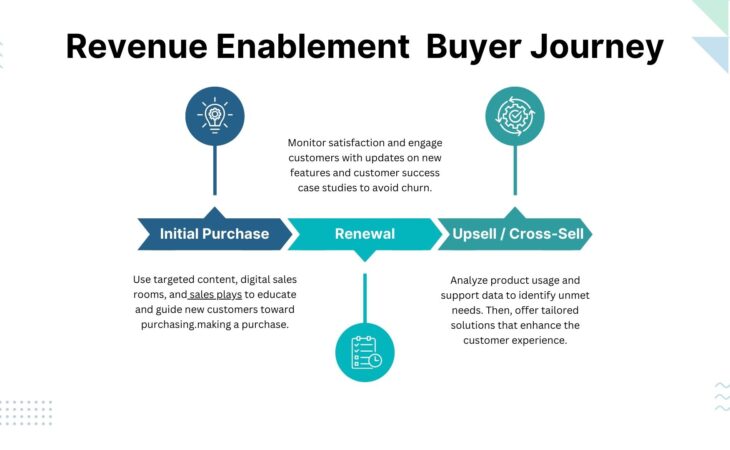Imagine that only 28% of your sales reps expect to hit quota. As a sales leader, you’d probably scoff at this. But according to Salesforce, this is the reality for many businesses, and the pressure to hit revenue targets has companies looking to improve sales processes to boost performance.
A quick Google search on “how to improve sales performance” will give you an exhausting list of things to try. From better coaching to setting clear goals to even hiring the right people. But every search result focuses on just one team: sales.
What’s missing is a strategic approach that unites all your revenue-generating teams. The buyer’s journey doesn’t just start and stop with sales. It requires multiple teams including marketing, customer success, account management, and more to optimize the sales cycle and performance.
Whether your revenue targets are at risk, you’re trying to turbocharge growth, or you’re looking to improve your bottom line, revenue enablement is for you. It is not a silver bullet, but those who invest in revenue enablement are expected to surpass their revenue goals by 80%.
Interested to learn more? Still on the fence? Either way, this blog is your next step – a comprehensive guide to understanding what revenue enablement is, how to get started, and so much more.
- What is Revenue Enablement?
- Why Do You Need Revenue Enablement?
- Revenue Enablement vs Sales Enablement: What’s the difference?
- How to Design a Revenue Enablement Organization
- Revenue Enablement Best Practices
- Integrating Revenue Enablement Across the Entire Customer Journey
- Building Your Revenue Enablement Tech Stack
- Overcoming Revenue Enablement Challenges
- Is Revenue Enablement Right for Your Business?
What is Revenue Enablement?
Revenue enablement is a strategic function that provides all customer-facing roles with the tools, data, and knowledge to maximize revenue throughout the customer journey. It goes beyond just supporting the sales team. It works to enable each channel and stage of the sales cycle that drives revenue growth, including marketing, customer success, account management, and more. The goal is to simplify the complexities of today’s selling environment and create a smoother experience for buyers and sellers.
Why Do You Need Revenue Enablement?
The current selling environment for new business and within your existing customer base is more complex, and intense, than any time in the past decade. To win, you must empower every individual who interacts with buyers and customers – or risk losing both new business and your existing base to your competitors.
When sales, customer success, and marketing teams are enabled and aligned, they are 67% more efficient at closing deals and 15% more profitable. The reason is that revenue enablement works to break down silos between sales and other departments through shared goals, technology, and centralized support. Let’s take a closer look at why you need revenue enablement:
- Focus on Business Outcomes: Drive C-Suite business objectives including revenue growth, customer satisfaction, and retention rather than just improving new business sales techniques.
- Continuous Process Improvement – Consistently evaluate and refine processes across all customer-facing teams to keep pace with market demands and customer expectations.
- Cross-Functional Alignment – Revenue enablement unites teams to improve the end-to-end revenue-generating process and dismantle organizational silos. Research shows that businesses that align technology, messaging, methods, and goals can drive a 5 to 10% increase in sales.
- Consistent Buyer Experiences – B2B buyers are more likely to complete deals when they receive consistent information from all supplier sources. Revenue enablement ensures that every customer-facing team knows what they need to know, making interactions smoother at every step.
To assess revenue enablement readiness for your business, consider the following questions:
- Do you have a clear understanding of your customer journey across all touchpoints?
- How well do your sales, marketing, and customer support teams collaborate?
- How could integrated technology and better data analysis enhance customer experience and outcomes?
- Can you quickly adapt your sales strategies based on customer needs and preferences?
- Are current workflows efficient, or do they detract from the customer experience?
- Does your sales enablement strategy align with your long-term objectives?
- Would, and could a transition to revenue enablement offer a more integrated approach?
Download Now: Gartner® Market Guide for Revenue Enablement Platforms
Revenue Enablement vs Sales Enablement: What’s the Difference?
While revenue enablement and sales enablement are related and often used interchangeably, each has its own scope, focus, and goals. Sales enablement teams aim to equip sellers with everything they need to close deals. On the other hand, revenue enablement brings all revenue-generating functions, such as marketing, customer success, support, and channel partners, together to streamline workflows and drive success.
Focus
Revenue Enablement: Align and optimize the entire revenue-generating process, from technology to data.
Sales Enablement: Focuses on activities directly related to sales, such as content, playbooks, and training.
Goal
Revenue Enablement: Enhance the customer experience at every touchpoint to maximize customer lifetime value and retention.
Sales Enablement: Improve the efficiency and effectiveness of the sales process to increase deal size and win rates.
Teams Involved
Revenue Enablement: Sales, Marketing, Customer Success, Revenue Operations
Sales Enablement: Sales, Product Marketing
How to Design a Revenue Enablement Organization
You’ve decided that revenue enablement is a good fit for your organizational goals, but how do you go about structuring your team and processes? Let’s take a closer look at what you need to get started:
Understand your Components
Every organization is unique, so the core components of your own approach to revenue enablement may differ. However, many companies that adopt revenue enablement include these elements:
- Sales Enablement: Equips sales teams with the training, tools, and content they need to sell. Sales enablement efforts span onboarding, ongoing sales training, and access to a content management system.
- Marketing Enablement: Ensures marketing strategies and materials support the sales process and drive demand. This includes lead generation programs, content marketing, and support for sales in the form of leads and market intelligence.
- Brand and Product Positioning: Define and communicate the unique value proposition of the brand and products to stand out against the competition. This ensures consistency across touchpoints.
- Customer Success: Maximizes customer satisfaction through a customer success team and/or online customer self-service resources. The goal is customer retention by providing support, education, and services that ensure customers achieve their desired outcomes.
Focus on Roles
Creating a revenue enablement organization requires a role-focused approach. Define roles within all departments that directly contribute to revenue generation. For each of these, outline responsibilities, required skills, and how each contributes to the customer’s journey and overall revenue goals. This will provide clear pathways for collaboration and crystallize the unique enablement needs of each role.
Align on Process Design
Revenue Enablement focuses on the entire customer experience, requiring you to design your processes aligned to your customers’ journey. You must thoroughly understand customer needs, pain points, and behaviors to create targeted messaging and content that engages customers at each stage of the buying journey. This involves designing processes that guide potential customers from awareness to purchase, loyalty, and post-sale advocacy.
Revenue Enablement Best Practices
Once you understand how to design a revenue enablement strategy for your business, it’s time to apply it in the real world. Let’s explore actionable tips for bringing this discipline into your business.
Align Revenue Teams on Common Goals
Align sales, marketing, and customer success teams with common objectives that drive revenue. Facilitate regular cross-departmental meetings, collaboration, and communication to keep everyone on the same page.
Promote a Revenue-Focused Culture
Encourage all employees to see their role through the lens of revenue impact. Create shared accountability for revenue outcomes and incentivize partnership on achieving these goals.
Establish a Structured Revenue Enablement Framework
Create a clear, documented revenue enablement plan that outlines tools, processes, and roles. Ensure it’s accessible to all relevant teams to guide their daily activities.
Adapt Your Strategy to the Customer Lifecycle
Analyze your typical customer journey and tailor your marketing, sales, and support teams to interact and add value to customers at each stage with relevant solutions, content, and messages.
Monitor and Optimize KPIs
Regularly track customer acquisition cost (CAC), customer lifetime value (CLV), sales cycle length, revenue growth, win rates, and conversion rates. Use insights from these metrics to improve your execution.
Implement Continuous Training and Development
Establish ongoing training programs for all customer-facing employees to keep their skills sharp and knowledge current. This includes regular training and targeted coaching on new product offerings or features, market trends, GTM activities, messaging, and sales tactics to ensure your team members are always equipped to win revenue opportunities.
Integrating Revenue Enablement Across the Customer Journey
These revenue opportunities arise throughout your customer relationships. Implementing revenue enablement across the buyer journey ensures value-added customer interactions from the initial purchase through renewal, upselling, and cross-selling. Here’s how to integrate it at every stage.

Building Your Revenue Enablement Tech Stack
Technology plays a large role in enabling all teams that interact with customers. The aim is to align your sales, marketing, and customer success strategies to achieve revenue targets guided by uniform data and metrics. Yet, one solution doesn’t fit all due to each business’s unique requirements.
Consider upfront and maintenance costs, integration, scalability, usability, features, and industry relevance when looking at each solution. Here are the standard tools needed to assemble a comprehensive tech stack tailored for revenue enablement:
Customer Relationship Management (CRM)
Your CRM acts as a central hub for managing all customer sales interactions. It stores data on customer behaviors, touchpoints, and sales activities. These platforms should integrate with other solutions to track customer relationships from first contact to ongoing retention.
Revenue Intelligence
These platforms analyze data across your teams to provide actionable insights, forecast revenue, and identify areas for sales performance improvement.
Sales Enablement Platform
Sales enablement solutions facilitate the materials and information sales reps need to engage with customers. This includes creating digital sales rooms, sales plays, content management, training and coaching capabilities, and analytics that deliver leading indicators about content, seller, and team performance.
Marketing Automation
These platforms automate marketing tasks such as email campaigns, social media posting on LinkedIn and other platforms, and ad campaigns, allowing for the coordinated and trackable allocation of marketing resources. This functionality enhances lead generation and nurturing.
Customer Success Management (CSM) Solutions
The customer success team requires these tools to help customers achieve their desired outcomes while using your product or service. This results in long-term loyalty and less churn.
Analytics Tools
Analytics may be built into the tech stack or standalone, depending on the complexity of reporting needs. A cloud data warehouse may be necessary to securely store vast amounts of data. These tools should provide comprehensive insights into customer behavior, campaign performance, and overall revenue health, enabling data-driven decisions.
When selecting tools for your revenue enablement strategy, prioritize solutions facilitating data sharing and collaboration. This ensures integration across all teams without data silos.
Download Now: Gartner® Market Guide for Revenue Enablement Platforms
Overcoming Revenue Enablement Challenges
While revenue enablement offers many advantages as your business evolves, implementation is not without its challenges. Recognizing and addressing these hurdles will set your teams up for success.
- Alignment: Achieving alignment across sales, marketing, and customer success teams can be difficult, especially in larger organizations where departments have historically operated in silos. Get stakeholders and leadership to buy-in and promote a culture of collaboration through regular cross-departmental meetings, shared goals, and consolidating measurements to ensure all teams are working towards the same revenue goals.
- Technology evolution: The pace of technology innovation means tools and platforms can quickly become outdated, making keeping your tech stack current challenging. Regularly evaluate your revenue enablement platform and invest in upgrades or changes to enhance your operations.
- Adoption: Often, new processes and tools will be met with resistance due to a lack of understanding of benefits. Put training and support programs in place to highlight the benefits of the latest tools and processes and implement incentives for adoption.
- Data quality and integration: Data integrity is always a complex undertaking, especially with multiple tools, processes, and teams. Invest in tools that work well together and establish data governance policies to ensure data quality and consistency.
Is Revenue Enablement Right for Your Business?
Now that you understand the concept, purpose, tools, and benefits of revenue enablement, you can consider if it makes sense for your business. If you manage diverse products or sales channels, are looking to achieve or outperform against your revenue goals, value your customers’ experience, and can invest in new resources, revenue enablement could be a perfect fit.
The traditional handoff mentality from marketing to sales to customer support no longer serves the needs of modern buyers. They seek a cohesive experience where every team is invested in their success. Revenue enablement provides this framework, empowering a unified go-to-market strategy that aligns all customer-facing teams toward a common goal. It fills the gaps between departments and builds trust with buyers.
Highspot stands at the forefront of revenue enablement, offering solutions that empower revenue-generating teams with streamlined processes, improved customer experiences, and steady revenue growth.
Request a demo today!




